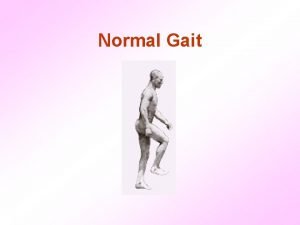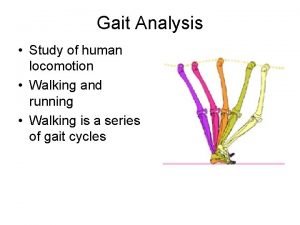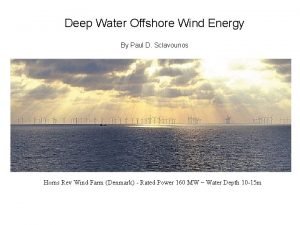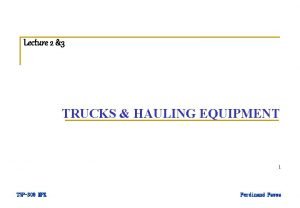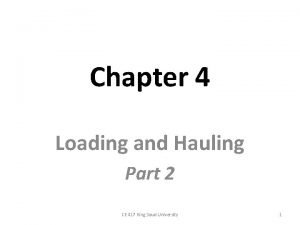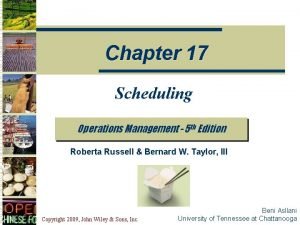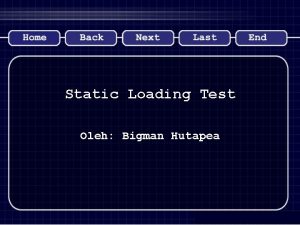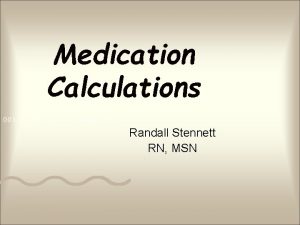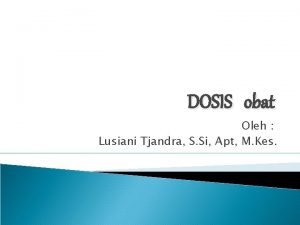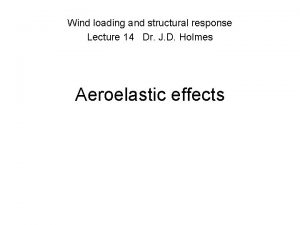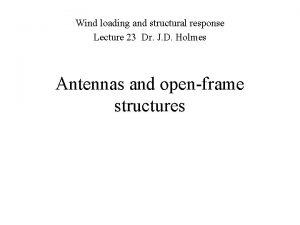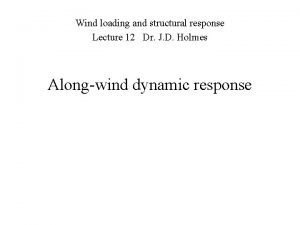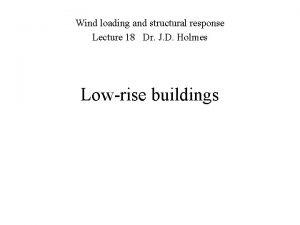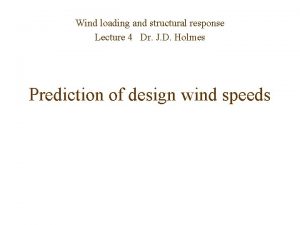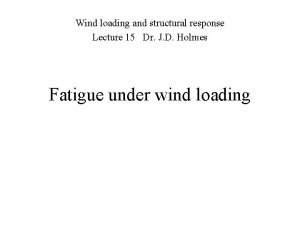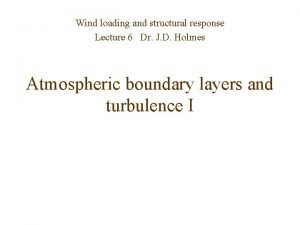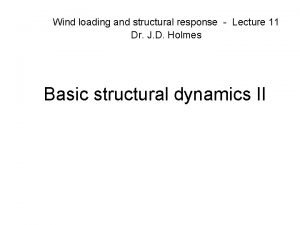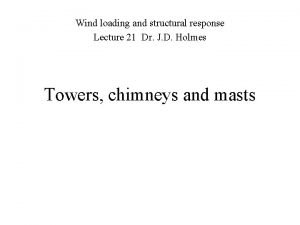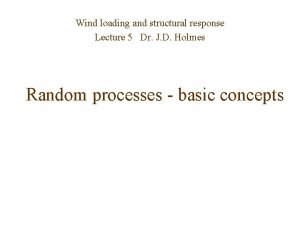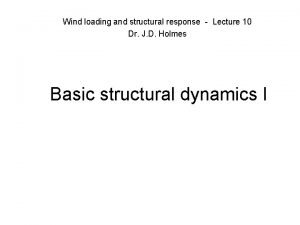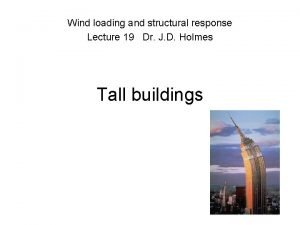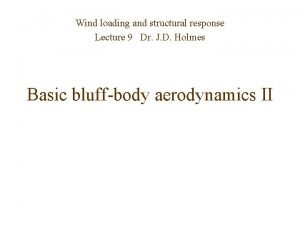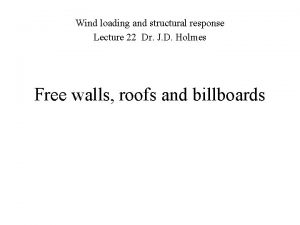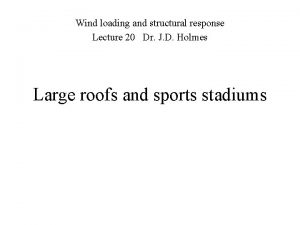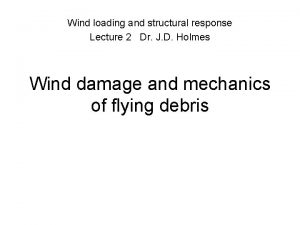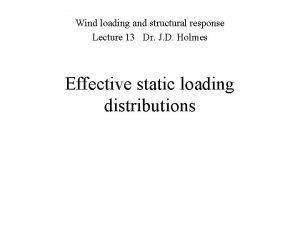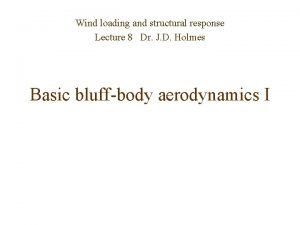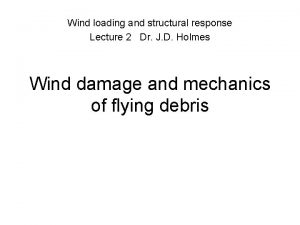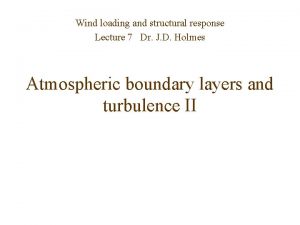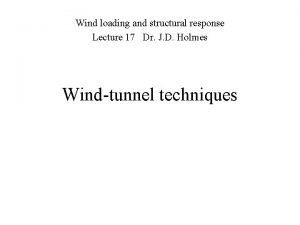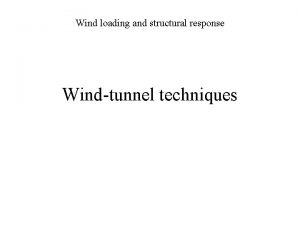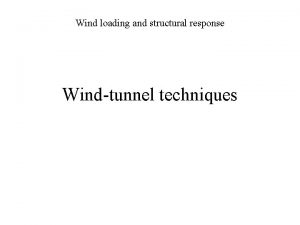Wind loading and structural response Lecture 1 Dr

































- Slides: 33

Wind loading and structural response Lecture 1 Dr. J. D. Holmes Meteorology of Windstorms

Meteorology of windstorms • Types of storms producing extreme winds : • extra-tropical depressions (gales) • synoptic scale 40 -60° latitude • tropical cyclones (hurricanes, typhoons) • synoptic scale 5°-30° latitude oceans and coast • thunderstorms (downbursts, tornados) • meso scale 0°-50° latitude local convection • downslope winds (chinook, Santa Ana) • meso scale certain topographic situations thermally driven

Meteorology of windstorms • Forces acting on air in horizontal motion : • Pressure gradient - pressure differences created by non uniform solar heating • Coriolis force - (apparent) force due to the earth’s rotation • Centrifugal force - air moving with small radius of curvature • Frictional forces - due to earth’s surface -significant at lower heights (boundary layer)

Meteorology of windstorms • Pressure gradient force : z p y z x y (p+ x y z Pressure gradient force per unit mass = x) y z

Meteorology of windstorms • Coriolis force : • an apparent force due to the rotation of the earth (S. Pole) AA = U ( t)2 = (½)a ( t)2 a=2 U

Meteorology of windstorms • Coriolis force : • acts to the right of the direction of motion in the northern hemisphere, and to the left of the velocity vector, in the southern hemisphere • Coriolis force per unit mass (acceleration) = 2 U sin = f. U = angle of latitude = angular velocity of the earth f= 2 sin Coriolis force is zero where and f are zero i. e. at Equator

Meteorology of windstorms • Geostrophic wind : • Balance between pressure gradient and Coriolis forces • Approximates wind speed in upper atmosphere • Ugeostrophic =

Meteorology of windstorms • Geostrophic wind : • Flow parallel to isobars • Anti-clockwise rotation around low pressure centre in N. Hemisphere

Meteorology of windstorms • Cyclonic systems : • Anti-clockwise rotation in Northern Hemisphere Clockwise rotation in Southern Hemisphere • direction of Coriolis force determines direction of rotation in cyclones including hurricanes Near the equator ( < 5° N), hurricanes cannot form

Meteorology of windstorms • Gradient wind : Includes centrifugal force : (U 2/r) per unit mass r = radius of curvature of isobars • Equation of motion : anti-cyclone Quadratic equations for gradient wind speed, U

Meteorology of windstorms • Gradient wind : • Solutions : anti-cyclone U is limited to for an anti-cyclone, but unlimited for a cyclone

Meteorology of windstorms • Frictional effects in ‘boundary layer’ : • Friction at earth’s surface acts in opposite direction to flow new force balance - component towards low pressure region as height decreases Direction change with height - Ekman spiral <30 o

Meteorology of windstorms • Characteristics of hurricanes : • Known as ‘typhoons’ in S. China sea and elsewhere as ‘tropical cyclones’ • Can exist between 5 and 40 latitude full strength between 10 and 30 latitudes • Require ocean temperature greater than 26 Celsius (79°F) taken to higher latitudes by warm ocean currents • 3 -dimensional vortex structure with ‘eye’ of calm winds

Meteorology of windstorms • Characteristics of hurricanes : (S. Hemisphere) • 3 -dimensional vortex structure with ‘eye’ of calm winds

Meteorology of windstorms • Variation of wind speed/direction at a point in a hurricane : Wind speed Direction (Figure 1. 7 in book shows low wind speed in ‘eye’)

Meteorology of windstorms • Wind field of hurricanes :

Meteorology of windstorms • Wind field of hurricanes :

Meteorology of windstorms • Saffir-Simpson scale for hurricanes :

Meteorology of windstorms • Profiles of pressure and gradient windspeed : pressure Holland (1980) pressure gradient p = pn-p 0 gradient wind speed where p 0 is central pressure

Meteorology of windstorms • Profiles of pressure and gradient wind : pressure profile gradient wind speed profile Cyclone ‘Tracy’ 1974

Meteorology of windstorms • Thunderstorm winds : • Severe winds in small areas generated by strong downdrafts and tornadoes • Conditions for generation of downdrafts – High wind shear – Supply of warm moist air at ground level – Uplift mechanism • Melting hail cools surrounding air – initiates downdraft – augmented by evaporating rain • Extreme winds are dominated by thunderstorm downdrafts in many locations : Argentina, South Africa, Central U. S. , Singapore ….

Meteorology of windstorms • Downbursts : • Macrobursts : > 4 km in horizontal extent • Microbursts : < 4 km in horizontal extent cumulus cloud warm air cool air • Largest documented wind speed : 67 m/s (130 knots), Andrews Air Force Base, Maryland, 1983 (anemometer record : Fig. 1. 9 in book)

Meteorology of windstorms • Downburst anemometer record : Max gust 1 hour Wind speed Direction

Meteorology of windstorms • Downburst wind speed footprint : 15 m/s 20 Direction of storm 30 40 50

Meteorology of windstorms • Tornadoes : Funnel-shaped vortex created in thunderstorms

Meteorology of windstorms • Tornadoes : ‘Supercell’ - intense convective cell

Meteorology of windstorms • Tornadoes : • Narrow width - typically 100 metres can be up to 1000 m • Can travel long distances before dissipation - up to 50 km (30 miles) • Most common in mid-West of U. S. (esp. Oklahoma, Kansas) also occur in Argentina, South Africa, India, Russia, Australia

Meteorology of windstorms • Tornadoes - Fujita scale:

Meteorology of windstorms • Regions exposed to tornadoes (ASCE 7 -95):

Meteorology of windstorms • Tornado wind field: • Can be modelled as a Rankine (combined) vortex: Tangential velocity Radial Vr 0. 5 V Static pressure Vertical Vv 0. 62 V

Meteorology of windstorms • Tornado damage footprint :

Meteorology of windstorms • Downslope winds : • Thermally driven - several different phenomena • usually occur on the lee slopes of mountains, or in valleys • U. S. : chinook winds (Colorado) Santa Ana winds (California) • Affect small areas • Dealt with in wind loading codes as ‘special wind regions’

End of Lecture 1 John Holmes 225 -405 -3789 JHolmes@lsu. edu
 Java dynamic class loading
Java dynamic class loading Perbedaan granit single loading dan double loading
Perbedaan granit single loading dan double loading Medical term for normal gait
Medical term for normal gait Parameters of gait
Parameters of gait 01:640:244 lecture notes - lecture 15: plat, idah, farad
01:640:244 lecture notes - lecture 15: plat, idah, farad Structural dynamics of deep water offshore wind turbines
Structural dynamics of deep water offshore wind turbines Kurshalter
Kurshalter Natural response and forced response
Natural response and forced response First order system transfer function
First order system transfer function A subsequent
A subsequent Dump truck productivity calculation
Dump truck productivity calculation Mould loading and unloading procedure
Mould loading and unloading procedure Hauling part
Hauling part Scheduling rules operations management
Scheduling rules operations management Azure sql data warehouse loading patterns and strategies
Azure sql data warehouse loading patterns and strategies What is linking and loading
What is linking and loading Mutoharoh
Mutoharoh Static loading test adalah
Static loading test adalah What are the objectives of size reduction
What are the objectives of size reduction Kov-21 error
Kov-21 error Radiographic darkroom layout
Radiographic darkroom layout Rumus dosis obat
Rumus dosis obat Orm mishap probability subcategory b
Orm mishap probability subcategory b Nmos inverter
Nmos inverter Bactrim pediatric dosing
Bactrim pediatric dosing Total body clearance equation
Total body clearance equation Geeks os
Geeks os Front end loading
Front end loading Finite vs infinite scheduling
Finite vs infinite scheduling Loading dose units
Loading dose units Loading dose units
Loading dose units Dynamic class loading
Dynamic class loading Rumus loading dose
Rumus loading dose Loading dose
Loading dose


